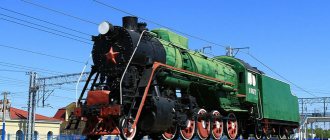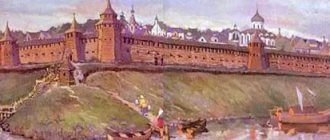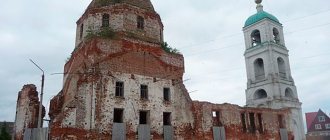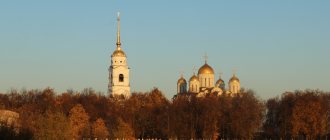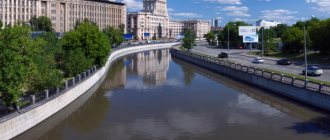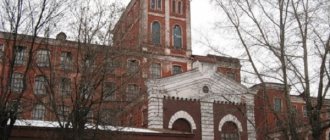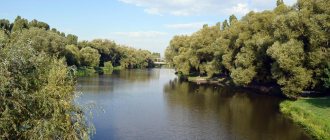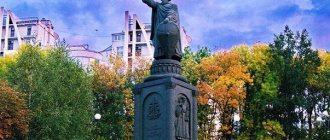We liked the Eagle, and we don’t regret spending two days on it. I also liked the guys Igor and Masha, with whom we stayed through couchsurfing. In addition, they showed the city and told us what to see in Orel in one day, and also revealed some secrets of the city: for example, we found out where the most delicious pizza is in Orel. The only thing that saddened me was that the girls were poisoned by something, and on the train on the way back they were very sick from their souls, and then, already at home, they took several days to come to their senses. But time passed and everything became fine.
Walking route. Historical Center
What to see in Orel? I’ll tell you about our route, which includes getting to know the historical center, visiting museums and the Oryol Arbat. A leisurely, non-tiring walk can easily take 3-4 hours. Of course, the historical center of the city is of interest in Orel. If you have enough time and you like to walk, then you can start your walk from the railway station: you need to walk along Moskovskaya Street towards the center, down to Peace Square with Tankmen Park and the Red Bridge over the Oka. The Red Bridge smoothly flows into Gostinaya Street, and we find ourselves in the historical center. If you are too lazy to walk or have little time, then we take any bus that goes along Moskovskaya Street and get off at the “Karl Marx Square” stop. We go back a little, and after about 150 m we find the Oryol Museum of Local Lore. It is quite worthy to be on the list of what to see in Orel in one day.
Beautiful places in Orel that are worth visiting
The Oryol region is rich in historical sights and untouched natural beauty. True Russian nature and famous places full of folk cultural traditions arouse the genuine interest of travelers from all over the world.
Oryol Polesie National Park
The protected areas of the national park occupy a vast territory. Here, Polesie, which has preserved its uniqueness, combines amazing nature and the historical heritage of the people.
There is no need for a tourist to visit Belarus to see a live bison. The giant bull also lives here, in the Oryol region. Experienced guides will help you walk along a comfortable ecological path to see this interesting miracle of nature. The park's areas include forested areas equipped with recreation areas, an open-air zoo of rare animals and birds, archaeological monuments, the Radovishchi settlement, and an old village. It's interesting to walk there.
Location: village. Zhudersky.
Opening hours: every day, 10.00-17.00.
You can get there by bus “Orel - Khotynets”, then by minibus to the stop “Usadba Polesya”.
Get directions
Source of Saint Kuksha
In the old days there lived Saint Kuksha, who preached Orthodoxy in the Oryol lands. The idol worshipers killed the saint. At the place of Kuksha’s death, a miraculous spring began to flow. Later a monastery was built and the spring was improved. Finding the source is easy. Wooden paths lead to the spring, a font is equipped, and a small church is built.
Location: village. Mtsensk.
You can visit the source 24 hours a day.
Travel by bus 128 to the Frolovka stop.
Get directions
Kuznetsovskie ponds
The townspeople's favorite vacation spot spreads over 25 hectares. Shallow ponds are rich in carp, grass carp, crucian carp, perch, and pike. They are separated by sectors for fishing and recreation. Picturesque places and sandy beaches have long been loved by local residents. Despite the active visitation by vacationers, free recreation areas - gazebos, tables, barbecues and bridges - are kept clean.
Location: Bolkhovsky district.
You can get there by bus "Orel - Kuznetsovsky".
Get directions
Cave "Water"
Thrill-seekers will find something to visit in Orel. The old cave is located within the city. The height of the ceilings of the former quarry is from 1 to 3 meters. The depth of underground lakes is up to 3 meters. The water is absolutely clear. Some places consist of clay islands. Others are completely flooded. Therefore, it is important that tourists are accompanied by an experienced speleologist. They travel around the cave only by boat.
Location: right bank of the Oka River, 500 m from the pier.
Excursions are possible during daylight hours.
Travel by tram 4, stop “Moldavskaya”, then walk to the pier or by car.
Get directions
Oryol Museum of Local Lore
Relatively small, but quite interesting museum. There are many exhibits with explanatory signs. You can watch without a tour. The exhibition includes exhibits from mammoth tusks to household items of the 19th century. I recommend paying attention to the models: once you get acquainted with them, you will learn what the city center looked like in ancient times, so that you can then compare it with the present while walking through the historical part of the city. The museum is closed on Monday. On other days it is open from 10.00 to 18.00, but on Thursday – until 21.00, and on Saturday and Sunday – until 17.00. Children pay 20 rubles, adult copies of children – 50 rubles. Students and pensioners are treated like children.
Interesting excursions
In Orel, as in any other large city in the country, you have a great opportunity to get to know the city better by using the services of travel companies or private guides.
If this is your first time in Oryol, you can start with an overview of the city. A walking tour is possible, and if you come with your own transport, then a tour in your car. You will learn all the most interesting things about the history of the city from the first inhabitants to the present day, see and photograph all the iconic city attractions and get answers to any questions you may have. In the summer, it is possible to take a boat tour along the Oka River, during which you will get acquainted with the natural and geographical position of Orel, its administrative structure, and attractions along the boat route. There are many excursion options: “Merchant Eagle”, “Eagle - a journey through time”, “Along the Kursk streets of Orel”, “Eagle - past and present”.
You can go on a thematic excursion “Literary Eagle”, during which you will be taken along the routes of writers whose destinies are closely connected with Orel, and will be introduced to the rich literary traditions of the city, which is called the literary capital of Russia. As part of the excursion, you can visit your choice of one of the literary museums of Orel. Excursions on a narrower topic are also possible, for example, “The Eagle in the Works of Leskov”, “Turgenev’s Places in Orel”.
Gazebo in the park “Noble Nest” Photo: © Anna Kudryavtseva
There are excursions outside the city. For example, the excursion “Krivtsovsky Memorial”, dedicated to the memory of the difficult days of the Great Patriotic War - the battles in the Bolkhov direction in February-March 1942. Or the excursion “To the Frontiers of Glory in Novosil”, where you will learn about the role and significance of the Oryol offensive operation, the heroism of the soldiers and commanders at the initial frontiers in the summer of 1943. There are dozens of options available, you can always choose what suits your interests.
Excursions “Across the Native Land of I. S. Turgenev” are always popular, during which they talk about the life and work of the writer, and also visit the Turgenev family estate Spasskoye-Lutovinovo .
Reviews from tourists about visiting the Spasskoye-Lutovinovo Museum-Reserve
Spasskoye-Lutovinovo Museum-Reserve Photo: © Andrey Semenov
The most delicious pizza in Orel
The guys we stayed with through couchsurfing advised us to definitely try this pizza. The inconspicuous pizzeria is located next to the local history museum in the city center. The guys say that when the neighboring bourgeois cafe “Slavutich” burned down, the townspeople were actively interested in whether this pizzeria had been damaged by the incident. There is always a queue near the inconspicuous small window for very tender and tasty food. I believe that if you have been to Oryol and have not tried this pizza, then consider that you have not recognized the city. So, if you are still wondering what to see in Orel in one day, start, of course, with the pizzeria! Joke. But in every joke... You can find it like this: we leave the local history museum and go to the other end of the building in which the museum is located. There is also an arch there. This wonderful place is located next to the arch. It is not very noticeable, so a photo is attached.
Orel Museums in 1 day
There are many museums in Orel, the oldest of which is the Museum of Local Lore , founded in 1897, and the youngest is the Museum of Collectible Dolls, opened in 2021. You can choose to visit the one that interests you.
Oryol United State Literary Museum of I. S. Turgenev
“The Oryol United State Literary Museum of I. S. Turgenev” includes six literary and memorial museums, the exhibitions of which are located in noble mansions of the 19th century:
- Museum of I. S. Turgenev
- Museum of Oryol Writers
- Leskov House-Museum
- House of Leonid Andreev
- Museum of I. A. Bunin
- House of T. N. Granovsky
Museum I.A. Bunina Photo: © Anna Kudryavtseva
Oryol Military History Museum
The exhibition of the Oryol Military History Museum is dedicated to the pages of the military history of the Oryol region and the participation of Oryol residents in the largest military campaigns of the 18th - early 20th centuries. Much attention is paid to the topic of liberation of the region from the Nazi invaders during the Great Patriotic War.
In the museum you can visit eight halls, where among the exhibits are rare collections of weapons and ammunition of warriors from different historical periods. The dioramas that attract the greatest interest among visitors are: “Breakthrough of the Nazi defense in the Oryol direction near the village of Maloye Izmailovo, Novosilsky district, July 12, 1943.” and “The Battle of Kromy in the fall of 1919 during the Civil War.”
Oryol Military History Museum Photo: © Anna Kudryavtseva
Memorial House-Museum of V. A. Rusanov
This unique museum of its kind was opened in Orel on Rusanova Street in 1982 in the house where V. A. Rusanov spent his childhood and youth. There are few museums dedicated to explorers of the North and the Arctic in Russia; the peculiarity of the House-Museum of V. A. Rusanov is that in the center of Russia, in the literary region, a museum of a polar explorer has been opened.
Rusanov gave his life in his attempt to explore and navigate the Northern Sea Route, a very economically beneficial route for Russia. The tragic death of the researcher still remains a mystery, and the museum’s exhibition tells about the attempts of our contemporaries to uncover this mystery. It was V. A. Rusanov who was the prototype of the hero of Veniamin Kaverin’s story “Two Captains”.
Memorial House-Museum of V. A. Rusanov Photo: © Anna Kudryavtseva
More information in the material Eagle Museums
Lenin Square
This is the main square of the city. I recommend climbing it from the arrow along Proletarskaya Gora Street. Along the way, you will also come across a monument to Bunin and a registry office: keep in mind, it might come in handy. The square is pedestrian and attracts young people for walking, rollerblading and cycling.
For those interested in writers, I recommend visiting museums dedicated to them. They are not that far from here anymore. Then you can return to Lenin Square and continue your walk along the pedestrian Lenin Street. Those who are not particularly curious about this can immediately go to Lenin Street, skipping the description of the museums.
Districts of Orel
Historically, three districts have developed in Orel around the founding site of the city - the Oka and Orlik arrows, the borders of the districts being the rivers themselves:
- Factory
district (old names: 1st part, Old Town) - it was in this part that there was the Oryol fortress, there was the oldest urban settlement - Posadskaya, before the revolution, mainly merchants and townspeople settled here; in Soviet times, large machine-building plants were built - hence the name; - Zheleznodorozhny
district (2nd part, Zaokskaya part) - initially the district was formed around the Moscow road and Okskaya pier, then it grew thanks to the railway station; - Sovetsky
district (3rd part, Zaorlitskaya part, Upper Town) - the administrative part of the city since the abolition of the military fortress; Before the revolution, mainly nobles settled here, after - the Soviet nomenklatura; this area has more museums than others.
In 1999, the fourth district of Orel, Severny
.
Turgenev Museum
Quite a good collection of documents, photographs and all sorts of things that are related to the life of the great writer. But without a tour it’s not interesting. Read a detailed report about the trip to the museum here. Good to combine with a walk around the city center. The museum is located on Turgenev Street, 11.
Brief history of the city of Orel
Orel was founded at the confluence of the Oka and Orel (later Orlik) rivers in 1566, during the reign of Ivan the Terrible
, like a border military fortress. Under Peter I, it ceased to be a fortress and, thanks to its advantageous position in the upper reaches of the Oka, became a major river port and center for trade in grain and salt.
In 1778 it became the center of the Oryol province
. In 1868, a railway appeared in Orel, and all trade moved to it, and the port-marina on the Oka fell into decay.
During Soviet times, Orel retained its administrative significance - as the center of the Oryol region
.
During the Second World War it was occupied by the Nazis for almost two years. Liberated on August 5
, 1943. In honor of the liberation of two cities - Orel and Belgorod - the first victory salute during the Second World War was given in Moscow - since then Orel has been called
the City of the First Fireworks
.
In the post-war period, Oryol significantly expanded its territory. A new district of the city has appeared, today called the Northern.
Eagle coat of arms.
Map of Orel from the early 20th century.
Districts of Orel.
Leskov Museum
The mansion in which the museum is located is a monument of federal significance. Located at st. Oktyabrskaya, 9. Take a look there to find out interesting details about the life of the author of “The Enchanted Wanderer.” The museum has a large collection of things, books and objects that belonged to Leskov. Open all days except Friday, from 10.00 to 17.00.
Sights of Oryol
Objects are numbered according to the map.
1
Trinity Cemetery
Founded in 1778. Representatives of the Oryol nobility of the 19th century, Soviet party leaders, artists and writers are buried here. There are Catholic and Lutheran sectors, and a separate military necropolis
.
In the Trinity Church
(1823) there is
a crypt of the family of General Ermolov
.
2
Assumption Monastery
Founded in the 16th century. In the 19th century served as the residence of the archbishops. Recreated on a historical site in the 1990-2000s. One church from the 19th century has survived.
3
Victory Boulevard
Memorial pedestrian zone. On the boulevard there are monuments to: WWII heroes Obraztsov
and
Sanko
, Heroes of the Russian Federation
Skvortsov
and
Ryazantsev
, General
Gorbatov
, the stele
“Eagle - the city of military glory”
and
a long-lived oak tree
.
4
Art Museum
5
Monument to General Gurtiev
Monument to L.N. Gurtiev (1891–1943) – major general who died in 1943 during the liberation of Orel. Sculpture by E.V. Vuchetich. Opened in 1954
6
Regional Library named after. I.A. Bunina
Regional library (building built in 1958) and a monument to I.A. Bunin (1992).
7
City Park
Founded in 1823. This is one of the oldest city parks in Russia. In 1968, a monument to I.S. Turgenev
(1818–1883).
8
The area named after Lenin
Central square of Orel. It was founded in the late 1940s on the site of the old boulevard. The ensemble of the square consists of the buildings of the Main Post Office, the regional administration, a theater, two hotels and the former Northern Bank of the early twentieth century. Lenin monument
(1949) in the center of the square is the oldest surviving Eagle monument.
9
Oryol State Academic Theater named after. I.S. Turgenev
The oldest theater in Orel, its history dates back to 1815, from the serf theater of Count Kamensky. The theater building was built in 1975.
10
Monument to Bunin
Monument to I.A. Bunin (1870–1953) Opened in 1995.
11
House-museum of the writer N.S. Leskova
12
"Noble Nest"
The square is named after Turgenev’s novel “The Noble Nest.” According to the Oryol legend, the basis for its plot was the story of a family that lived in this place in the first half of the 19th century. The first garden with this name was opened here in 1903.
13
Memorial workshop and art gallery of artist A.I. Kurnakova
14
Theater "Russian Style" named after. MM. Bakhtin
15
Historical and literary quarter
A fragment of historical buildings, including museums: Oryol Writers
,
I.S.
Turgeneva ,
I.A.
Bunina ,
T.N.
Granovsky .
16
"Kakhovka"
Monument to the heroes of the Civil War.
17
Lenin Street
Lenin Street (formerly Bolkhovskaya) - “Oryol Arbat”, the main street of Orel in the 19th century. Since the 1970s it has been completely pedestrian.
18
Arrow
Place where the city of Orel was founded. Land area between the Oka
and
Orlik
, where in 1566 a fortress was founded, named after the river - Orel (from the 18th century - the Orlik River).
In 1966, a 27-meter granite stele
and
a square dedicated to the 400th anniversary of the Eagle
.
19
Epiphany Cathedral (late 17th – early 18th centuries)
The oldest stone building in Oryol and the only one preserved from the times of the Oryol fortress.
20
Monument to Ivan the Terrible
The first monument to Ivan IV the Terrible (1530–1584) in Russia. Opened in 2016
21
Red Bridge
Built in the 1950s on site and incorporating designs from the Mariinsky
bridge of the 19th century
22
Gostiny Dvor (shopping arcade)
Built in 1849 on the site of the burnt Gostiny Dvor of the 18th century. Since 1932, part of the building has been occupied by the Oryol Museum of Local Lore
.
23
Alexander Bridge
Built on the site of a 19th century bridge. named after Emperor Alexander II, and destroyed during the Second World War. The official name of the modern bridge is Leninsky
, but townspeople more often call it Aleksandrovsky.
24
Central Bank building
Built in 1899 for the Oryol Commercial Bank
. The best example of “Russian style” architecture in Orel.
25
Theater "Free Space"
The building was built in 1799 for the city Magistrate
, later –
the City Duma
.
26
Faculty of History of OSU
Building 1795 In the 19th century. it had a classical men's gymnasium
.
In front of the building there are busts of famous students of the gymnasium: Andreev
,
Rusanov
,
Stolypin
and others.
27
Monument to N.S. Leskov
A sculptural ensemble depicting the writer Nikolai Leskov (1831–1895) surrounded by the heroes of his works: “The Stupid Artist”, “Lady Macbeth of Mtsensk”, “The Enchanted Wanderer”, “Lefty”, “The Cathedral People”. Opened in 1981
28
Church of the Archangel Michael (Uspenskaya)
Built at the beginning of the 19th century. Mentioned in the works of Leskov, Bunin, Andreev. Next to the temple, on Karachevskaya Street, is the St. Michael the Archangel Chapel
- the only one preserved in the city from the 19th century.
29
Monument to A.P. Ermolov
Monument to General Ermolov (1777–1861), hero of the Patriotic War of 1812, “proconsul of the Caucasus,” who came from the Oryol nobles and was buried in Oryol. Opened in 2012
30
Monument to V.S. Kalinnikov
Monument to the composer Kalinnikov (1866–1901), a native of the Oryol province. Opened in 2009
31
House-museum of the writer L.N. Andreeva
The house in which Leonid Andreev (1871–1919) spent his youth.
32
Trinity-Vasilievskaya Church (mid-18th century)
33
"House of the Serebrennikov merchants"
Former apartment building, a monument of Art Nouveau architecture. Beginning XX century
34
Military History Museum and T-70 Tank Monument
35
Church of the Smolensk Icon of Our Lady (second half of the 19th century)
36
Nikolo-Peskovskaya Church (late 18th century)
37
Baptist Cemetery
Founded in 1772. Representatives of famous merchant families of the 19th century are buried here. In the Baptist Church
(1774) the chains and vestments
of Tikhon of Zadonsk
.
38
Station and Station Square
Created in the 1950s. on the site of a 19th century train station, destroyed during the Second World War. Monument "Eagle-Jubileer"
installed on the square in 2021
39
Church of the Iveron Icon of the Mother of God (early 20th century)
40
Monument to N.N. Polikarpov
Monument to aircraft designer Polikarpov (1892–1944), a native of the Oryol province, a graduate of the Oryol Theological Seminary.
41
“House of Merchants Perelygins” and a monument to Mikhail Romanov
Building 1856 At the beginning of the 20th century. it housed the headquarters of the Oryol Chernigov regiment, commanded by the brother of Emperor Nicholas II, Grand Duke Mikhail Alexandrovich (1878–1918). A monument to him will be unveiled in front of the building in 2021.
42
"The House of Merchant Apollonov"
Built at the end of the 19th century. like a residential building with a grocery store on the ground floor. Well preserved exterior and interior in eclectic style. Currently it is a railway technical school.
43
"Todorov's House"
A residential building with architecture at the intersection of constructivism and Stalinist Empire styles. Built according to the design of Oryol architect A.S. Todorov in 1936. After the liberation of Orel on August 5, 1943, the Victory Banner was raised on the building.
44
Tankmen Square
Eagle's main war memorial. In the depths of the square there is a mass grave
tankers who died in August 1943. In 1968,
the T-34 tank
and the Eternal Flame was lit.
In 2021, a monument to Marshal I.Kh.
Bagramyan .
45
House-Museum of V.A. Rusanova
The house-museum of Rusanov (1875–1913), a revolutionary, geologist and polar explorer, who was born in Orel and went missing during one of his Arctic expeditions.
46
Church of the Akhtyrka Icon of the Mother of God (late 18th century)
47
Vvedensky Convent
Founded in Orel in the 17th century. It moved to its current location in the late 1840s. Two churches from the 19th century, fragments of the fence and individual cells have been preserved.
© D. Kirilyuk, design, graphics, photos, 2018–2020 © D. Furmanskaya, D. Kirilyuk, text, 2020
Places for active recreation
The Oryol region is not only about religious shrines and abandoned estates. Athletes are also welcome here and are always welcome. All conditions have been created for active recreation in the region.
Gorki 57
- Coordinates: 53.087247, 36.061860.
The active recreation park, located near Orel, is the only all-season resort in the region. You can ski and snowboard here both in winter and summer thanks to artificial snowmaking. Visitors are offered a choice of 6 trails of varying difficulty with height differences of up to 60 m.
Those who don't like skiing can go tubing. There are 2 descents equipped for them. The park has lighting, so you can ride until late in the evening, and fresh air and a beautiful panorama are a pleasant bonus to your relaxation.
Pronino
- Coordinates: 53.141464, 36.207343.
The Pronino tourist center, located near Orel, will appeal to winter sports enthusiasts. All types of skis, snowboards, sleds, steep slopes and turns. And, of course, a powerful adrenaline rush. The slopes here are prepared not only for experienced skiers.
Beginners who want to try their hand are offered a specially equipped, lightweight track and the accompaniment of an instructor. In addition, Pronino is not only a tourist base. Regional alpine skiing competitions are held here every year.
Zlynsky stud farm
- Coordinates: 53.275266, 35.963898.
The life's work of V.N. Telegin, a great lover of horses, is a stud farm in the village of Zlyn. It was founded in 1872. First in the Kolpnyansky district, but later it was moved to Orlovsky, where it is located to this day.
At first, Telegin bred only Oryol trotters. Then, crossing them with an American standardbred horse, he developed a new breed - the Russian Trotter. Money from the sale of horses and victories in competitions went to the maintenance of the winners themselves and the development of a stud farm.
After the revolution, it was practically destroyed by hungry peasants; only a couple of valuable horses were saved.
In the 20s of the last century, the stud farm opened again, but during the Second World War it was destroyed and plundered by the Nazis. And only five years after the victory, good times came for him. The stud farm was able to survive and maintain its livestock even in the difficult 90s.
National parks and reserves
Nature is everything that surrounds us. But there are special places that have no analogues. For this purpose, protected areas are created to preserve the wonderful landscapes of the Oryol region.
Oryol Polesie
- Coordinates: 53.255652, 35.294967.
The national park is located on the territory of Znamensky and Khotynetsky districts, covering an area of more than 75 thousand hectares. It was formed in 1994 on the initiative of Academician of the Russian Academy of Sciences E. S. Stroev.
Characters from Turgenev’s “Notes of a Hunter” lived here, Nightingale the Robber and his gang took refuge here, the ancient village of Lgov and the remains of the ancient Russian fortress Khotiml are located. Oryol Polesye is home to the largest population of bison and muskrat, and there are more than 170 species of rare plants.
Shatilovskaya experimental station
- Address: Novoderevenkovsky district, Shatilovo village, 79.
One of the main attractions of the Oryol region is located in the former Shatilov estate. For 125 years now, research has been carried out here, selection work has been carried out, new varieties have been developed, and fertilizers have been tested.
The modern station cooperates with many research institutes and experimental sites not only in Russia. Material for research is sent even from abroad.
And it all started with 65 hectares of land, which I.I. Shatilov dedicated his family estate to the introduction of advanced farming techniques.
Here, at different times, plant nutrition and the use of phosphorus fertilizers, the influence of various agricultural practices on crop yields were studied. Many famous scientists worked in Mokhovoy, such as breeder P.I. Lisitsyn.
Oryol Arboretum
- Coordinates: 53.003971, 36.070381.
The dendrological park belongs to the All-Russian Research Institute for Selection of Fruit Crops. It began to be created in 1968. All botanical gardens of the Soviet Union were involved in the creation of collections.
Today, about 300 rare plants from all over the world are collected here. There is a very rare cherry birch, with red-brown bark. And the relict Radde birch - the same age as dinosaurs - is listed in the Red Book.
Oryol waterfalls and springs
Springs are phenomena that not only can, but must be admired. It is from them that people need to learn perseverance and the ability to reach their goals.
Source of the Oka
- Coordinates: 52.357282, 36.216463.
One of the largest rivers in Europe begins in the Glazunovsky district of the Oryol region, near the village of Aleksandrovka. This is a small spring flowing into a man-made stone pool.
The area around it is considered a park area, surrounded by walls, and has an entrance gate. The space next to the pool is decorated with wooden figurines of fairy-tale characters, and there is a chapel nearby.
Source of Saint Kuksha
- Coordinates: 53.342596, 36.428532.
John Kuksha is one of the most revered saints in the Oryol region, a preacher of Christianity who lived 900 years ago. The spring that bears his name is located in the forests of the Mtsensk region.
According to legend, it was at this place that Saint Kuksha was killed by the pagans. It has survived to this day only because it was located in a hard-to-reach place.
Today the area around it is landscaped. A wooden stage leads to the covered font, and there are benches for rest everywhere. Visitors note that everything here breathes purity and goodness.
Holy spring Kamenets
- Coordinates: 52.479833, 36.829423.
One of the most mysterious places in the Oryol region is located in the Pokrovsky district. The source itself has been known since the 16th century, but only recently have they begun to refine its territory and study its phenomenal properties.
The spring is a deep ravine, the bottom of which is lined with stone slabs with an uneven surface. The entire area around it is strewn with the same stones.
These amazing stones are considered alive and are credited with healing properties, like spring water. They look really unusual. It was as if they had been heated, causing the surface to boil and bubble, and then suddenly cooled.
A metal staircase leads to the source and there is a swimming pool. There are bridges across the stream, and the faces of saints are located on the stones.
Lukovetsky waterfalls
- Address: Lukovets village, Maloarkhangelsk district.
The hydrological natural monument is located in the Maloarkhangelsk region, near the village. Onion. These are groundwaters that come to the surface from Devonian limestones, forming 4 powerful springs.
The first source is at the base of the ravine, the rest are downstream of the river. Pine. Falling from a meter height, they form waterfalls. The water in them has no taste or smell, is clean and transparent.
Where the water from the third spring falls, a spring comes out of the ground. The water in it is completely different from that in the springs. Although it is transparent, it has a yellowish tint and an iron taste.
Holy Spring of John the Baptist
- Coordinates: 53.282433, 36.563983.
A spring under the Cathedral Mountain in Mtsensk appeared, according to legend, in 1415. Then almost the entire population of the city gathered on the right bank of the Zushi. The occasion was a huge stone floating along the river with an image of St. Nicholas the Wonderworker and a cross carved on it.
Before the eyes of the amazed residents, the stone stuck to the mountain, and in that very place a spring began to flow. Having witnessed such a miracle, the townspeople were baptized, and a church was installed on the top of the mountain. The source still exists today. A roof was installed over it, a bathhouse was built, and the area around it was landscaped.
